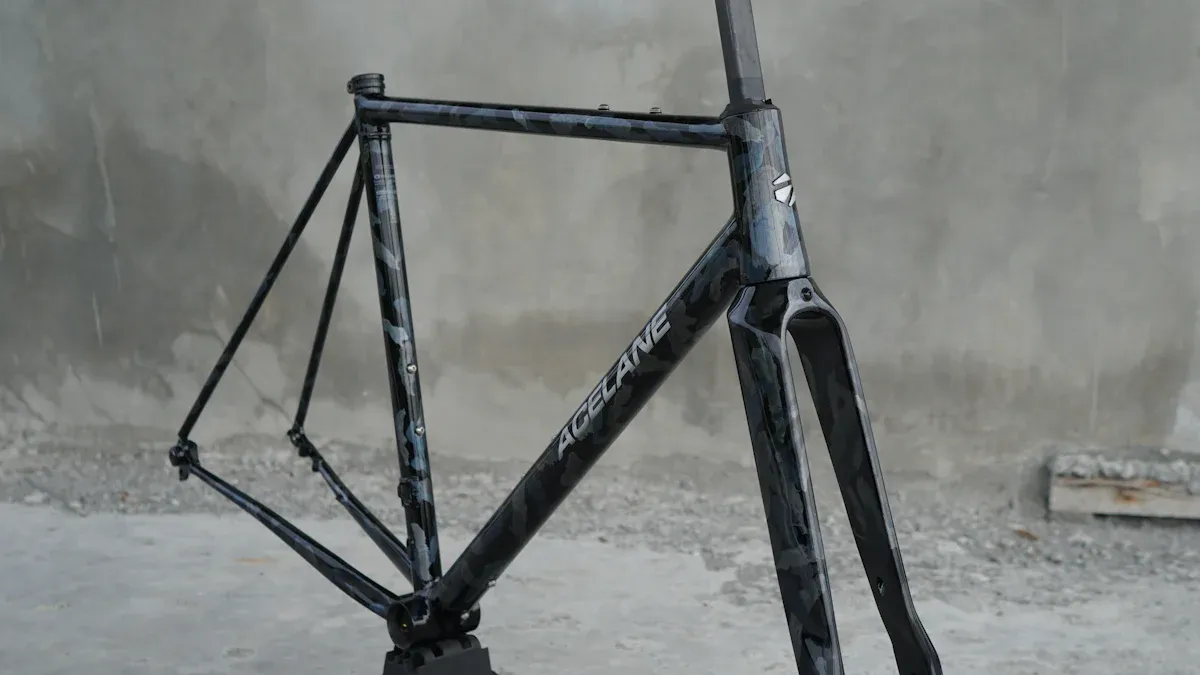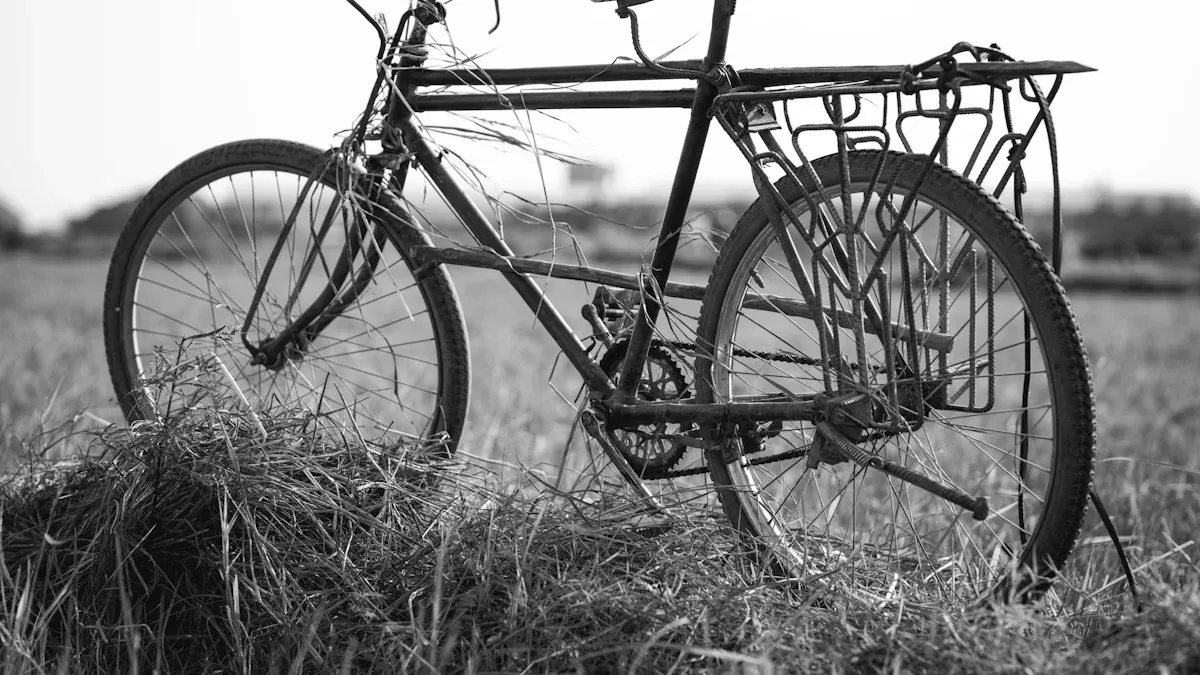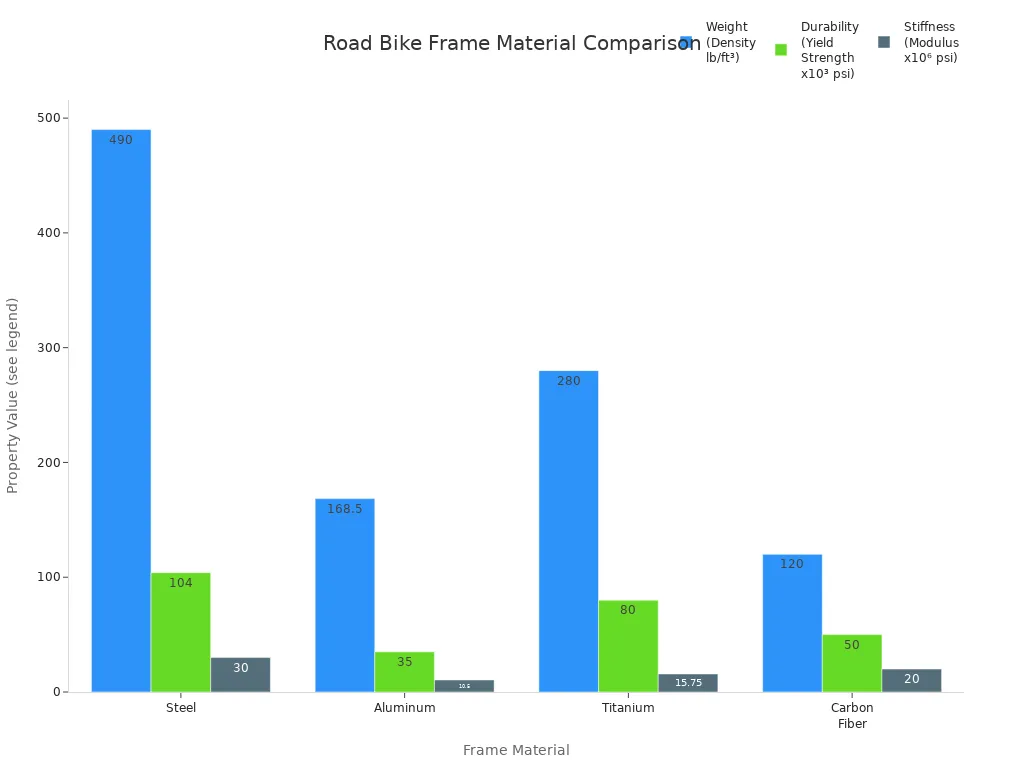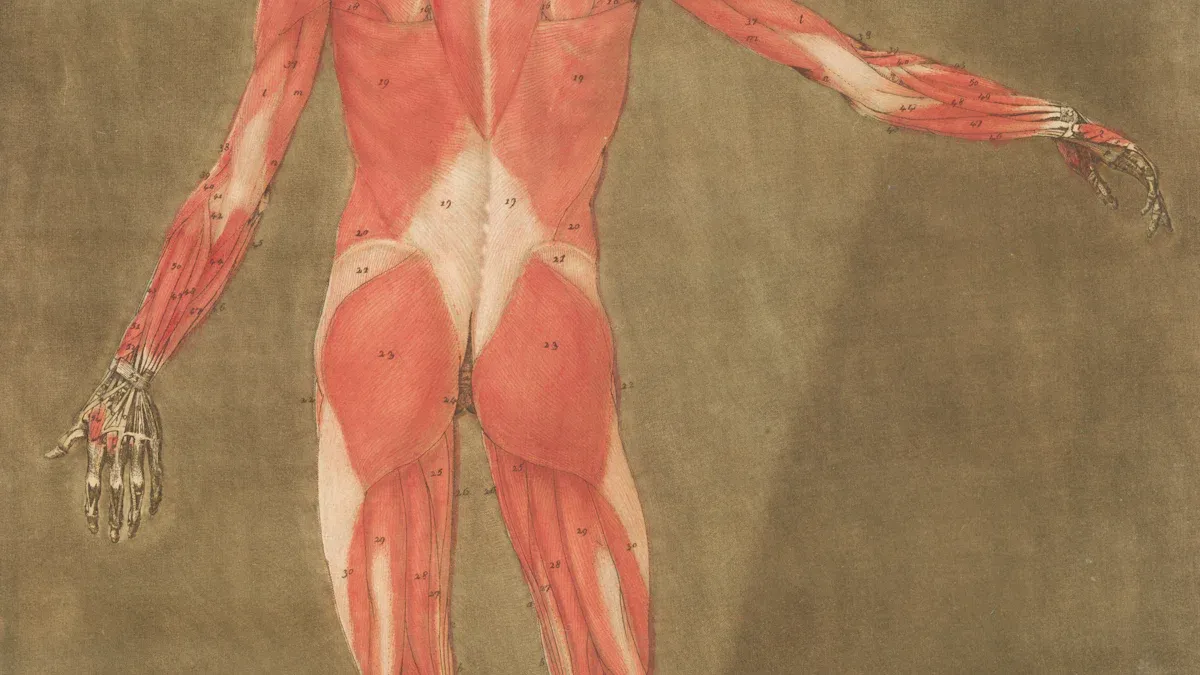
When you look at a bike, you see many parts working together. The main bike frame part names include the top tube, down tube, seat tube, head tube, chainstay, seat stay, and bottom bracket shell. Each part gives the bike its strength, shape, and support. You use the bike frame to hold the wheels, seat, and handlebars in place. Every bike relies on these parts for safety and comfort.
Knowing bike frame part names helps you care for your bike, upgrade parts, and choose the right bicycle. Use this simple bicycle anatomy guide to learn more about bike anatomy and how each part makes your ride better.
Key Takeaways
Knowing bike frame parts like the top tube, down tube, seat tube, and chainstay helps you see how your bike stays strong and works right.
Different materials like aluminum, steel, titanium, and carbon fiber change how your bike feels, rides, and how long it lasts.
Each frame part has a special job. The head tube helps you steer. The bottom bracket lets you pedal easily.
Learning about bike parts helps you pick the best bike, keep it safe, and make good upgrades.
Good bike design uses strong shapes and materials. This keeps your ride steady, comfy, and easy to use.
Bike Frame Part Names

Top Tube
The top tube runs horizontally between the head tube and the seat tube. You see it as the uppermost tube on most bikes. This part helps set the overall geometry and fit of your bike. The diameter and material of the top tube affect how stiff or flexible your frame feels. A larger diameter makes your bike stiffer and more responsive, which is great for racing or rough terrain. A smaller diameter allows more flex, giving you a smoother ride for longer distances. The top tube also plays a big role in weight distribution and handling, making it a key part of your bike frame.
Tip: The material of your top tube—aluminum, steel, titanium, or carbon fiber—changes how your bike feels. Aluminum is light and stiff, steel is strong and comfortable, titanium is light and durable, and carbon fiber is stiff and light.
Material | Characteristics & Effects on Performance |
|---|---|
Aluminium | Lightweight, stiff, corrosion resistant, cost-effective. Fatigues faster than steel, titanium, and carbon fiber. |
Steel | Durable, strong, comfortable, heavier, prone to rust, easily repaired. |
Titanium | Light, strong, less stiff, expensive, good fatigue resistance. |
Carbon Fiber | Very light, stiff, high strength-to-weight ratio, superior fatigue resistance. |
Down Tube
The down tube connects the head tube to the bottom bracket shell. You find it as the longest tube on your bike frame, sloping downward. This part gives your bike strength and rigidity. It supports your weight and helps your bike handle bumps and vibrations from the road. The down tube often has mounts for water bottles and sometimes houses cables for shifting gears. Its main job is to keep your bike frame strong and stable, making sure you stay safe and comfortable while riding.
Seat Tube
The seat tube runs vertically from the bottom bracket shell up to the seat post. You use it to adjust your saddle height for comfort and pedaling efficiency. The seat tube supports your weight by holding the seat post and saddle. It connects with the seat stays and chainstays, forming the rear triangle of your bike frame. The angle of the seat tube changes how you sit and pedal. A shallow angle puts you further behind the bottom bracket, which feels more comfortable for long rides. A steep angle moves you forward, helping you pedal faster but can feel harsher.
Seat Tube Angle Range | Rider Position Relative to Bottom Bracket | Muscle Engagement | Pedaling Efficiency & Comfort Effects | Additional Notes |
|---|---|---|---|---|
Further behind | Quadriceps, glutes | Better for climbing, more comfort | More frame flex, smoother ride | |
75-78 degrees | Further forward | Hamstrings | Aerodynamic, faster cadence | Stiffer frame, harsher ride |
It connects with seat stays and chainstays for stability.
You adjust saddle height using the seat post inside the seat tube.
Head Tube
The head tube sits at the front of your bike frame. It holds the fork and connects to the handlebars, letting you steer your bike. The angle and length of the head tube affect how your bike handles. A steeper angle makes your bike turn quickly and feel more agile. A slacker angle gives you more stability, especially at high speeds. The head tube works with the fork to keep your bike stable and easy to control.
Steeper head tube angles make steering quicker and more responsive.
Slacker angles increase stability and smoothness, better for rough terrain.
The head tube length changes your reach and riding position.
Chainstay
The chainstay is one of the most important bike frame parts. You find it running from the bottom bracket shell to the rear dropouts, forming the lower part of the rear triangle. The chainstay connects the crank area to the rear wheel, helping transfer your pedaling power to the wheel. It also absorbs impacts from the chain and rough terrain, protecting your frame from damage. Using a chainstay protector helps prevent dents and chips, keeping your bike frame strong.
Longer chainstays make your bike more stable, especially when climbing or riding fast.
Shorter chainstays give you quicker acceleration and sharper handling.
The chainstay affects weight distribution, comfort, and how your bike feels on different surfaces.
Protecting the chainstay is important for your bike’s performance and safety.
Seat Stay
The seat stay runs from the top of the seat tube down to the rear dropouts. You see it as the upper part of the rear triangle. The seat stay helps support your weight and absorbs shocks from the road. It works with the chainstay to keep your bike frame stiff and strong. The design of the seat stay changes how your bike feels. Road bikes often use dropped seat stays for more comfort and aerodynamics. Mountain bikes use seat stays as part of the suspension system, focusing on durability and traction.
Seat stays form strong triangles with other tubes for frame strength.
They help absorb shocks and improve comfort.
Modern designs change seat stay shape for better ride quality and performance.
Bottom Bracket Shell
The bottom bracket shell sits at the center of your bike frame, where the seat tube, down tube, and chainstays meet. It houses the bottom bracket assembly, which includes bearings and a spindle. You attach the crankset to the spindle, allowing it to rotate smoothly. The shell’s size and threading affect which cranksets and bottom brackets you can use. Modern bikes use different shell types, like threaded or press-fit, to match new crankset designs.
Description | Compatibility Notes | |
|---|---|---|
English (BSA) Threaded | Most common, internal threads | Fits many modern cranksets |
Italian Threaded | Used on Italian bikes | Not compatible with English |
Press Fit (General) | No threads, bearings pressed in | Compatibility depends on shell width and bore size |
T47 Threaded | Larger diameter, threaded | Allows press-fit style bearings with threaded cups |
Dropouts
Dropouts are the slots at the rear of your bike frame where you attach the wheel axle. You use them to install and remove your wheels. Dropouts come in different types, like vertical, horizontal, and thru-axle. Vertical dropouts make wheel installation easy and quick. Horizontal dropouts let you adjust chain tension, which is useful for single-speed bikes. Thru-axle dropouts provide a stronger, more secure connection, especially for bikes with disc brakes.
Dropouts keep your wheels aligned and secure.
They may include derailleur hangers and eyelets for racks or mudguards.
Modern dropout designs adapt to new axle standards, making your bike more versatile and durable.
Note: Modern dropouts, like the Portage Dropout system, let you change axle spacing and mounting standards without replacing your whole frame. This makes your bike future-proof and easier to upgrade.
Additional Bike Frame Parts
Braze-Ons
Braze-ons are small metal fittings attached to your bike frame. You use them to mount racks, water bottle cages, cable stops, and other accessories. Skilled builders attach braze-ons using silver soldering, which creates a strong bond with the frame. You can add braze-ons yourself if you have metalworking experience, but most riders prefer to buy bikes with these features already installed. Braze-ons make your bike more useful by giving you secure places to attach racks for carrying gear or water bottles for long rides. You also find braze-ons for cable routing, which helps keep your drivetrain running smoothly and your handlebar area tidy. Some braze-ons increase frame rigidity, especially when used as bridges between seat stays, which also provide mounting points for fenders. Proper placement of braze-ons ensures that your bike braking system and drivetrain components work as intended.
Fork
The fork connects the front wheel to your bike frame. You steer your bike by turning the fork with the handlebar. The fork also absorbs shocks and vibrations from the road or trail, which makes your ride smoother and more comfortable. Suspension forks use springs and dampers to soak up bumps, while rigid forks transfer more vibration to your hands and handlebar. The fork consists of several parts:
Fork Component | Function |
|---|---|
Steerer Tube | Connects the fork to the head tube, allowing steering through the handlebar. |
Stanchions | Slide into the fork legs, providing shock absorption on suspension forks. |
Fork Legs (Lowers) | Hold the stanchions and house the suspension system, guiding movement and absorbing hits. |
Damper | Controls how quickly the fork compresses and rebounds, smoothing out rough terrain. |
Spring | Absorbs impacts, either with air or coils, for comfort and control. |
A well-designed fork improves your bike’s handling, comfort, and control. The fork and frame must match for proper fit and performance.
Chain Guard
A chain guard covers the chain and part of the drivetrain. You use a chain guard to protect your clothing and shoelaces from getting caught in the chain, which helps prevent accidents. The chain guard also keeps dirt, water, and debris away from the drivetrain components, making your bike last longer and shift more smoothly. By keeping the chain aligned with the sprocket teeth, the chain guard helps your drivetrain work efficiently. You will notice fewer skipped gears and less wear on your drivetrain when you use a chain guard. This part is especially helpful for city bikes and bikes used for commuting.
Tip: Always check that your chain guard fits your bike and drivetrain for the best protection and performance.
Frameset
The frameset forms the core of your bike. It includes the frame and the fork. You build your bike around the frameset, choosing compatible parts like the handlebar, bike saddle, wheels, and drivetrain components. The frameset determines which brakes, wheels, and tires you can use. The fork and frame connect through the headset, which must match both the fork steerer and the head tube. The frameset’s geometry affects how your bike handles, how you sit, and how you reach the handlebar. You can find framesets with special fittings for racks, fenders, and bottle cages, making your bike more versatile. Accurate measurements of the frame and fork ensure that all parts fit together and work as a complete system.
Note: When you choose a frameset, you set the foundation for your bike’s performance, comfort, and upgrade options.
Parts of a Road Bike
Road Bike Frame Features
When you look at a road bike, you see how each part helps you go fast. The road bike frame uses a special shape called aggressive geometry. You lean forward when you ride. This makes you faster and helps you cut through the wind. Most road bikes have drop handlebars. These let you put your hands in different places for comfort and control. The seat is slim and hard. It is made for speed, not comfort. Your weight spreads across the saddle, handlebars, and pedals. This setup helps you ride longer and faster.
Here are some things that make road bikes different from other bikes:
The frame is lighter than mountain or hybrid bikes.
Drop handlebars help you ride faster.
The frame shape makes you lean forward.
The seat is small and built for speed.
The frame uses carbon fiber, aluminum, or titanium.
You get a smooth ride on paved roads.
The design is all about speed and efficiency.
Mountain bikes have longer frames. They are made for rough trails and control. Hybrid bikes have upright frames. They are built for comfort and safety. Road bikes are made for speed. Every part helps you go faster and makes the bike lighter.
Material Types
You pick road bike parts based on the frame material. Each material changes how your bike feels and works. Aluminum is the most common. It is light, strong, and not too expensive. Carbon fiber is used for fancy bikes. It is the lightest and can be made stiff or soft. Steel gives you a smooth ride and is easy to fix. Titanium is comfy and lasts a long time, but it costs more.
Industry data shows aluminum frames are the most popular. They are cheap and work well. Carbon fiber frames are getting more popular as technology gets better. Steel and titanium are less common but have special benefits.
Here is a table that compares the main materials used in road bikes:
Frame Material | Weight | Durability | Stiffness | Ride Quality Notes |
|---|---|---|---|---|
Steel | Heaviest | Very durable | Very stiff | Smooth, lively ride, easy to repair |
Aluminum | Light | Less durable | Stiff | Fast, responsive, can feel harsh |
Titanium | Medium | Most durable | Moderate | Comfortable, corrosion resistant, expensive |
Carbon Fiber | Lightest | Variable | Tunable | Excellent ride quality, expensive, less repairable |

You notice the ride feels different with each material. Steel and titanium soak up bumps. This makes long rides easier. Aluminum is fast and stiff. Carbon fiber helps you go faster with less work. You choose the material that fits your style and budget.
Bicycle Anatomy Guide

How Frame Parts Work Together
When you look at the anatomy of a bike, you see how each part connects to form a strong and efficient machine. The frame acts as the backbone, linking the top tube, down tube, seat tube, chainstay, seat stay, and bottom bracket. These parts create a sturdy triangle shape that supports your weight and keeps the bike stable. The head tube holds the fork, which lets you steer and control the bike. The chainstay and seat stay form the rear triangle, helping transfer your pedaling power from the crank to the rear wheel through the drivetrain.
Each frame part has a special job. The top tube and down tube give the bike horizontal and vertical stiffness. The seat tube holds your saddle and supports your body. The bottom bracket shell houses the crankset, which is central to power transfer. The chainstay and seat stay keep the rear wheel in place and help absorb bumps. If any part gets damaged, like a crack in the frame or a dent in the chainstay, the bike loses strength and may not work safely. High-quality materials and careful construction help prevent defects that can weaken the frame and reduce performance.
Frame Part | Role in Bike Anatomy and Performance |
|---|---|
Top Tube | Adds horizontal stiffness, connects seat tube to head tube |
Down Tube | Provides vertical strength, links head tube to bottom bracket |
Seat Tube | Supports rider weight, holds seatpost and saddle |
Chainstay | Transfers pedaling force, supports rear wheel |
Seat Stay | Adds stiffness, completes rear triangle |
Bottom Bracket | Central to drivetrain, transfers power from pedals to chain |
Strength and Stability
You want your bike to feel strong and stable on every ride. Engineers use smart design choices to make sure the frame can handle bumps, turns, and heavy loads. They use triangles and braces to spread out forces and avoid weak spots. Welds and joints must be smooth and strong, so the frame does not crack or bend. Special shapes and materials, like butted tubes or carbon fiber, help balance weight and strength.
Modern bikes use computer models to test frame shapes before building them. This helps find the best design for strength and comfort. The frame must also work with the fork, wheels, and drivetrain to keep the bike balanced and easy to control. When you understand bike anatomy, you can choose the right size and shape for your body. This helps you ride longer, avoid injuries, and get the most from your bicycle.
Tip: Knowing the bike anatomy helps you spot problems early, adjust your riding position, and keep your bike safe and efficient.
A good bicycle anatomy guide shows how the frame, fork, and drivetrain work together. This knowledge helps you care for your bike, make upgrades, and enjoy a safer, smoother ride.
You gain confidence when you know the names and functions of each bike frame part. This knowledge helps you care for your bike, choose upgrades, and make smart purchases. Use the table below to remember how each part works and why it matters:
Bike Frame Part | Function and Importance |
|---|---|
Bottom Bracket | Lets you pedal smoothly and transfer power. |
Braze-ons | Hold accessories like water bottles and brakes. |
Chainstay | Moves force from pedals to the rear wheel. |
Down Tube | Supports your weight and holds cables. |
Dropouts | Keep your wheels secure and easy to remove. |
Front Triangle | Supports you and connects key parts. |
Head Tube | Controls steering and bike handling. |
Tip: Keep this guide and table handy for quick reference when you maintain or upgrade your bike.
FAQ
What is the most important part of a bike frame?
You rely on the frame as the main structure. It connects all other parts and supports your weight. Without a strong frame, your bike cannot stay safe or work well.
How do I know if my bike frame fits me?
You should stand over the frame. There should be space between you and the top tube. When you sit, your legs should reach the pedals with a slight bend in your knees.
Can I replace just one part of my bike frame?
You can replace some parts, like the fork or dropouts. If the main frame tubes crack or bend, you usually need a new frame. Always check with a bike shop before making changes.
Why do bike frames use different materials?
Different materials change how your bike feels and performs. Aluminum is light and stiff. Steel is strong and smooth. Carbon fiber is very light. Titanium lasts a long time. You choose based on your needs and budget.
See Also
Key Bike Frame Components Every Cyclist Needs To Understand
Understanding The Main Bike Frame Parts And Their Functions
Differences Between Fat Bike And Mountain Bike Frames Explained
Track Bike Frame Materials And Their Importance To Performance
